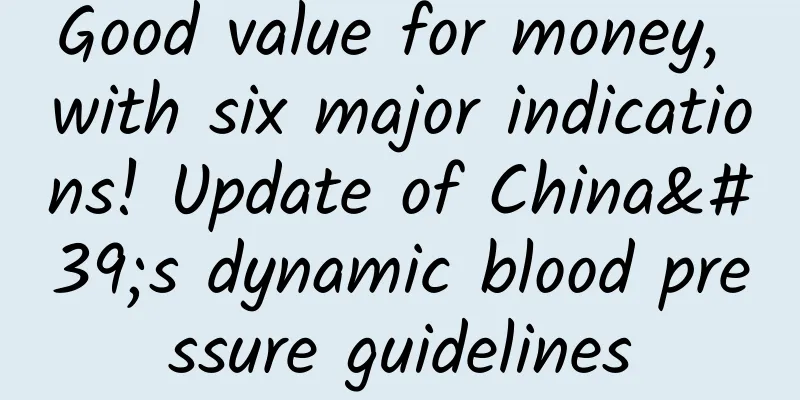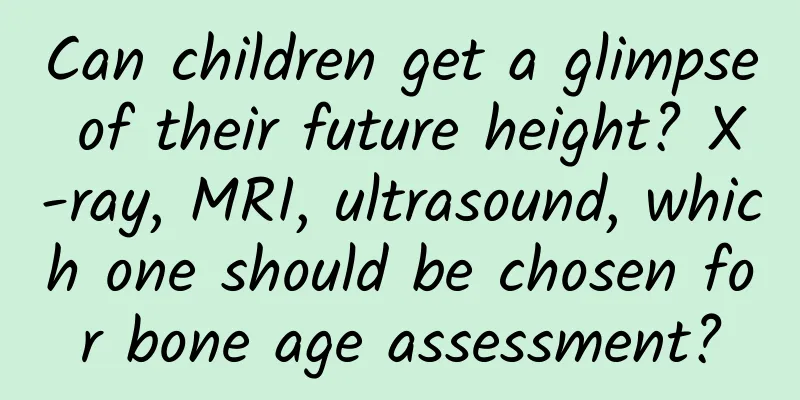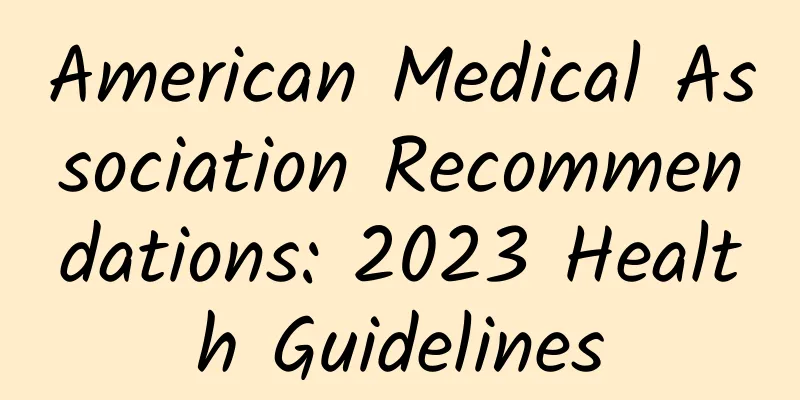Good value for money, with six major indications! Update of China's dynamic blood pressure guidelines

|
Recently, the China Hypertension League published the 2020 China Ambulatory Blood Pressure Monitoring Guidelines in this journal [1]. This guideline is an update of the "Expert Consensus on the Clinical Application of Ambulatory Blood Pressure Monitoring" published in 2015. The guidelines point out that dynamic blood pressure monitoring has four main functions: improving the accuracy of hypertension diagnosis; improving the level of risk assessment; evaluating the effectiveness of antihypertensive treatment; and guiding individualized treatment of hypertension. 1. Value for money British and American scholars have found that although dynamic blood pressure monitoring has a certain cost, it can reduce the misdiagnosis of hypertension, provide effective targeted treatment, and significantly reduce cardiovascular and cerebrovascular events, ultimately saving costs. Chinese scholars have also found that, according to the most conservative estimates, every 1 yuan invested in dynamic blood pressure monitoring can save 12 yuan in medical expenses in the next 5 to 7 years. 2. There are two major indications: to confirm the diagnosis of hypertension and to evaluate the efficacy of antihypertensive treatment. There are three types of situations in which hypertension should be clearly diagnosed: (1) newly discovered grade 1-2 office hypertension; (2) high-normal office blood pressure, but with combined target organ damage or high cardiovascular risk; (3) large blood pressure fluctuations, or suspected orthostatic hypotension, postprandial hypotension, secondary hypertension, etc. There are also three categories for evaluating and optimizing the antihypertensive effect: (1) The clinic blood pressure has reached the target, but cardiovascular and cerebrovascular complications still occur, or new target organ damage appears; (2) The diagnosis of refractory hypertension is clear, or the clinic blood pressure is not up to the target; (3) In clinical trials, the antihypertensive effect of drug or device therapy is evaluated. The guidelines recommend that patients with hypertension and concurrent obesity, metabolic syndrome, diabetes, kidney disease, obstructive sleep apnea-hypopnea syndrome, etc. often have an increased risk of latent hypertension, abnormal circadian rhythm of blood pressure, and large blood pressure fluctuations. Therefore, dynamic blood pressure monitoring is needed to accurately assess blood pressure and blood pressure variability. It should be noted that when using dynamic blood pressure monitoring to evaluate the effectiveness of antihypertensive treatment, the original antihypertensive drug treatment should be maintained and there is no need to discontinue antihypertensive drugs. For those with asymmetric blood pressure in both arms, make sure to select the side with higher blood pressure for monitoring. Due to the absolute irregular heart rhythm in patients with atrial fibrillation, single blood pressure measurement is prone to errors, and multiple measurements can improve the accuracy of blood pressure assessment. However, in several published small sample studies, there was no significant difference in the success rate of dynamic blood pressure monitoring in patients with atrial fibrillation compared with those in sinus rhythm. 3. Diagnostic Criteria Corresponding to the clinic blood pressure of 140/90 mmHg, a 24-hour average blood pressure ≥130/80 mmHg, or a daytime average blood pressure ≥135/85 mmHg, or a nighttime average blood pressure ≥120/70 mmHg is considered to be hypertension. The corresponding values of clinic blood pressure and dynamic blood pressure at each level are shown in the table below. 4. Blood Pressure Load: No Additional Value In clinical research, blood pressure measurement time and blood pressure are often plotted as a curve, and the area under the curve when blood pressure exceeds the normal value is taken as blood pressure load. However, the guidelines point out that after taking into account the average of systolic and diastolic blood pressure, blood pressure load has no additional predictive value for target organ damage or the risk of complications. 5. Morning hypertension: defined as average blood pressure ≥135/85 mmHg in the early morning Definition: Morning hypertension is defined as an average level of ambulatory blood pressure ≥135/85 mmHg during the early morning period, regardless of whether blood pressure is elevated during other periods. Early morning is a peak time for cardiovascular and cerebrovascular events. The peak incidence of myocardial infarction, sudden cardiac death and stroke is 4 to 6 hours before and after awakening. However, there is also a view [2] that home blood pressure monitoring may have better repeatability than dynamic blood pressure monitoring for early morning blood pressure measurements and may be more closely related to target organ damage. Therefore, although dynamic blood pressure monitoring can also be used to measure and manage morning blood pressure, home blood pressure monitoring may have greater clinical application value. 6. Nocturnal hypertension: The prevalence rate among Chinese is higher than that in Europe and America Compared with daytime blood pressure, nighttime blood pressure is more closely related to the risk of all-cause mortality and cardiovascular and cerebrovascular mortality, and nighttime blood pressure can predict the risk of death independently of daytime blood pressure. The guidelines point out that the prevalence of isolated nocturnal hypertension in the Chinese population is about 10.0%, which is significantly higher than that in European and American populations (6.0%~7.9%). This may be related to the common occurrence of salt-sensitive hypertension in the Chinese population, high-sodium diet, and increased proximal tubular sodium and reabsorption. After excluding secondary factors, the guidelines recommend three options for daytime and nocturnal hypertension: (1) use long-acting drugs alone or in combination to control; (2) use new antihypertensive drugs that can effectively lower nocturnal blood pressure, such as sacubitril/valsartan; (3) take medium- and short-acting antihypertensive drugs before bedtime to further control nocturnal hypertension. For hypertensive patients with non-dipper and anti-dipper blood pressure rhythm, it is advisable to strengthen nighttime blood pressure control; for hypertensive patients with super-dipper blood pressure rhythm, care should be taken to avoid excessive drop in blood pressure at night, which may increase the risk of ischemic cardiovascular and cerebrovascular events. 7. Refractory hypertension: the white coat effect needs to be excluded For suspected refractory hypertension, many of them are caused by the white coat effect, so true and false refractory hypertension can be distinguished based on the results of dynamic blood pressure monitoring. Foreign studies have shown that among 8,295 patients suspected of having refractory hypertension, dynamic blood pressure monitoring results showed that 37.5% had a white coat effect, that is, pseudo-refractory hypertension. 8. Hidden hypertension: Overweight/obesity, smoking, metabolic syndrome and chronic kidney disease are high-risk groups The guidelines point out that the prevalence of masked hypertension in my country is about 10% to 18%. The cardiovascular and cerebrovascular risks of patients with masked uncontrolled hypertension are about 1.8 times that of patients with normal blood pressure control. However, in clinical practice, it is not realistic to screen all patients with normal blood pressure in the clinic for masked hypertension. The guidelines recommend screening high-risk groups for masked hypertension, such as men, overweight or obese patients, smokers, and patients with metabolic syndrome and chronic kidney disease. For patients whose office blood pressure is at a normal to high level, but who have obvious target organ damage and no other obvious risk factors for cardiovascular and cerebrovascular diseases, it is necessary to consider 24-hour dynamic blood pressure monitoring to screen for hidden hypertension to avoid missed diagnosis. 9. Parkinson's disease patients: often combined with postural hypotension and reverse dipping blood pressure Cardiovascular autonomic dysfunction is one of the common non-motor symptoms in patients with Parkinson's disease, often manifested as abnormal blood pressure variation, and may even appear before motor symptoms occur. A multicenter Parkinson's disease patient registry study in my country reported that among Parkinson's disease patients with no history of abnormal blood pressure, approximately 25% had orthostatic hypotension and more than 50% had reverse dipping blood pressure. If the patient's 24-hour blood pressure circadian rhythm shows an inverted dipper, the probability of having orthostatic hypotension is significantly increased. Parkinson's patients with orthostatic hypotension have more severe non-motor symptoms, autonomic dysfunction and cognitive impairment, and more severe cardiovascular and cerebrovascular damage. 11. It is recommended to use standardized dynamic blood pressure monitoring reports. The content of 24-hour dynamic blood pressure monitoring reports should be standardized, and the content of dynamic blood pressure reports generated by different devices should be homogenized. 12. Promote dynamic blood pressure monitoring in the community The community is the main battlefield for the prevention and treatment of hypertension, but primary medical and health institutions face practical problems such as lack of dynamic blood pressure monitoring equipment, lack of experienced doctors who can analyze and interpret dynamic blood pressure reports, and poor patient compliance. In order to optimize and improve the quality of hypertension management in the community, the guidelines recommend improving the accessibility of community dynamic blood pressure monitoring from multiple dimensions and promoting the homogeneity of monitoring quality. The guidelines also recommend the promotion and application of networked dynamic blood pressure remote analysis and reporting platforms and medical alliance models to address the bottleneck of insufficient professional and technical manpower at the grassroots level. source: [1] National Hypertension League "Ambulatory Blood Pressure Monitoring Guidelines" Committee. 2020 China Ambulatory Blood Pressure Monitoring Guidelines. Chinese Journal of Circulation, 2021, 36: 313-328. DOI:10.3969/j.issn.1000-3614.2021.04.001. [Press and hold or scan the QR code below to get the full text] [2] Wang Jiguang. Interpretation of the consensus of Asian experts on ambulatory blood pressure monitoring. Chinese Journal of Circulation, 2019, 34(z1): 7-10. DOI: 10.3969/j.issn.1000-3614.2019. Supplement.003 Reprint: Please indicate "China Circulation Magazine" |
<<: Hallucination: The human brain's journey through reality
Recommend
What are the small particles under your eyes? Pay attention to these 4 points
Many people have small pimples under their eyes a...
Menstrual period is delayed, what methods can make menstruation come
Delayed menstruation is very common in life, beca...
Is it serious if the fetus is two weeks smaller?
Pregnant mothers are very concerned about the var...
What causes small bumps on the genitals?
When some small bumps appear on a woman's gen...
What to do if the vulva is itchy and tingling
For female friends who have vulvar itching, it is...
Is HPV82 positive serious?
Is a positive HPV82 test serious? HPV82 is a type...
How to tell if a pregnant woman is malnourished
Supplementing adequate nutrition for women after ...
Why does a woman have pain on the left side of her waist?
Low back pain is a common symptom among women. Di...
How to change the bank card bound to the electronic social security card? How to check the social security card of children through Alipay
Recently, I have found that many friends encounte...
How to make follicles develop better?
The follicle is the biological unit of the female...
How to do aerobics to reduce thigh fat?
For some people who sit for a long time, it is no...
How to choose Changbai Mountain ginseng? How to distinguish the authenticity of Changbai Mountain ginseng?
Ginseng is warm in nature and sweet in taste. It ...
How much does a cesarean section cost?
Although choosing natural childbirth can reduce t...
Is bacterial vaginitis easy to eradicate?
Female friends with bacterial vaginitis must pay ...
How to cut duck gizzards into flowers? How to deal with duck gizzards
Many friends have a special liking for food and l...









